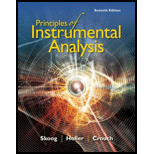
Principles of Instrumental Analysis
7th Edition
ISBN: 9781305577213
Author: Douglas A. Skoog, F. James Holler, Stanley R. Crouch
Publisher: Cengage Learning
expand_more
expand_more
format_list_bulleted
Question
Chapter 13, Problem 13.5QAP
Interpretation Introduction
Interpretation:
The molar absorptivity of the
Concept introduction:
The molar absorptivity of a solution is defined as the capacity of a solution to absorb the particular
Now, the relation between the molar absorptivity, absorbance and concentration of the solution is given by the relation.
Expert Solution & Answer
Trending nowThis is a popular solution!

Students have asked these similar questions
The reaction of phenylmagnesium bromide (C6H5MgBr) with propanal (CH3CH2CHO)3 followed by hydrolysis yields.
A. 2-phenyl-1-propanol
B. 1-phenyl-1propanol
C. 3-phenyl-2-propanol
D. 3-phenyl-1-propanol
Why is the correct answer B? Please explain what is happening. Please include a detailed explanation and/or a drawing of steps needed to understand the reaction or question.
What is the product of the reaction sequence below? Why is the correct answer D? Please explain what is happening. Please include a detailed explanation and a drawing of steps needed to understand the reaction or question.
The part that is under the pen in the image is (1) CH3CHO (2) H3O+
What is the missing reactant in this organic reaction?
R+
OH
HD
CH3-CH2-CH-CH3
H
A
CH3
CH3-CH2-C-O-CH-CH2-CH3
+ H₂O
Specifically, in the drawing area below draw the condensed structure of R.
If there is more than one reasonable answer, you can draw any one of them. If there is no reasonable answer, check the No answer box under the drawing area.
No answer
Click anywhere to draw the first
atom of your structure.
☐ :
Jm
+
Chapter 13 Solutions
Principles of Instrumental Analysis
Ch. 13 - Prob. 13.1QAPCh. 13 - Prob. 13.2QAPCh. 13 - Prob. 13.3QAPCh. 13 - Prob. 13.4QAPCh. 13 - Prob. 13.5QAPCh. 13 - Prob. 13.6QAPCh. 13 - Prob. 13.7QAPCh. 13 - At 580 nm, which is the wavelength of its maximum...Ch. 13 - Prob. 13.9QAPCh. 13 - Zinc(II) and the ligand L form a 1:1 complex that...
Ch. 13 - The equilibrium constant for the conjugate...Ch. 13 - The equilibrium constant for the reaction...Ch. 13 - Prob. 13.13QAPCh. 13 - Prob. 13.14QAPCh. 13 - Prob. 13.15QAPCh. 13 - Prob. 13.16QAPCh. 13 - Prob. 13.17QAPCh. 13 - Prob. 13.18QAPCh. 13 - Prob. 13.19QAPCh. 13 - Prob. 13.20QAPCh. 13 - Prob. 13.21QAPCh. 13 - Prob. 13.22QAPCh. 13 - Prob. 13.23QAPCh. 13 - Prob. 13.24QAPCh. 13 - Prob. 13.25QAPCh. 13 - Prob. 13.26QAPCh. 13 - Prob. 13.27QAP
Knowledge Booster
Similar questions
- Draw the major product of the following E2 reaction. Make sure you pay attention to REGIOCHEMISTRY and STEREOCHEMISTRY. Explain why this product is formed using 10 words or less for each. (a) NaH Br acetone TSO, NaH (b) acetonearrow_forward2. Circle the compound that will react SLOWER in an E2 reaction. To get credit for this question, you must EXPLAIN how you got your answer using STRUCTURES and WORDS. Br ** Br...arrow_forward8. 2 20 00 Draw ALL of the possible products for the following reaction CIRCLE the MAJOR product NaOMe MeOHarrow_forward
- NAME: 1. Draw the major product of the following E2 reaction. Make sure you pay attention to REGIOCHEMISTRY and STEREOCHEMISTRY. To get credit for this question, you must EXPLAIN how you got your answer using STRUCTURES and WORDS. Br NaOCH3 acetone F2 reaction To get credit for thisarrow_forward3. Reactions! Fill in the information missing below. Make sure to pay attention to REGIOCHEMISTRY and STEREOCHEMISTRY. Br2 CH3OH + 4. Mechanism! Show the complete arrow pushing mechanism, including all steps and intermediates for the following reactions. To get credit for this, you MUST show how ALL bonds are broken and formed, using arrows to show the movement of electrons. H3O+ HOarrow_forwardPlease provide a synthesis for the Ester using proponoic acid, thank you!arrow_forward
- Please help with the curved arrow mechanism of this reaction, thank youarrow_forwardConcentration (mg/l) Peak Area 0 158 10 10241 20 18425 30 26457 40 37125 50 44256 60 56124 Question: Determine the regression equation (a and b coefficients) from first principlesarrow_forwardConcentration (mg/l) Peak Area 0 158 10 10241 20 18425 30 26457 40 37125 50 44256 60 56124 You have been asked to determine the concentration of citral in a highly valued magnolia essential oil. QUESTION: Calculate the concentration of citral in your highly valued magnolia essential oil which returns a peak area of 41658arrow_forward
- Need help with these problems...if you can please help me understand problems E & F.arrow_forwardPlease help me solve these problems. Thank you in advance.arrow_forwardPredict the products of this organic reaction: O N IN A N + H2O + HCI ? Specifically, in the drawing area below draw the skeletal ("line") structure of the product, or products, of this reaction. If there's more than one product, draw them in any arrangement you like, so long as they aren't touching. If there aren't any products because this reaction won't happen, check the No reaction box under the drawing area. 田 C + Explanation Check Click and drag to start drawing a structure. C © 2025 McGraw Hill LLC. All Rights Reserved. Terms of Use | Privacy Centerarrow_forward
arrow_back_ios
SEE MORE QUESTIONS
arrow_forward_ios
Recommended textbooks for you
 Principles of Instrumental AnalysisChemistryISBN:9781305577213Author:Douglas A. Skoog, F. James Holler, Stanley R. CrouchPublisher:Cengage Learning
Principles of Instrumental AnalysisChemistryISBN:9781305577213Author:Douglas A. Skoog, F. James Holler, Stanley R. CrouchPublisher:Cengage Learning

Principles of Instrumental Analysis
Chemistry
ISBN:9781305577213
Author:Douglas A. Skoog, F. James Holler, Stanley R. Crouch
Publisher:Cengage Learning